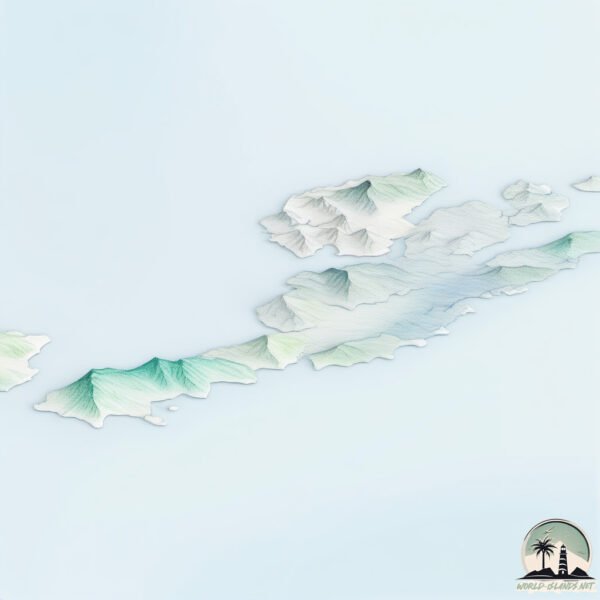Unalaska

Welcome to Unalaska, a Polar island in the Bering Sea, part of the majestic Pacific Ocean. This guide offers a comprehensive overview of what makes Unalaska unique – from its geography and climate to its population, infrastructure, and beyond. Dive into the details:
- Geography and Size: Explore the island’s size and location.
- Climate and Weather: Weather patterns and temperature.
- Topography and Nature: Uncover the natural wonders of the island.
- Infrastructure and Travelling: Insights on reaching, staying, and making the most of your visit.
- News and Headlines: Latest News.
Geography and size of Unalaska
Size: 2698 km²
Coastline: 1559 km
Ocean: Pacific Ocean
Sea: Bering Sea
Continent: North America
Unalaska is a Very Large Island spanning 2698 km² with a coastline of 1559 km.
Archipel: Aleutian Islands – A chain of islands stretching from Alaska to Russia, known for their rugged beauty, abundant wildlife, and volcanic activity.
Tectonic Plate: North America – Covers North America and parts of the Atlantic and Arctic Oceans, characterized by diverse geological features and varying levels of seismic activity.
The geographic heart of the island is pinpointed at these coordinates:
Latitude: 53.66767394 / Longitude: -166.89256063
Climate and weather of Unalaska
Climate Zone: Polar
Climate Details: Tundra
Temperature: Cold
Climate Characteristics: The tundra climate features long, extremely cold winters and short, cool summers. Vegetation is limited to mosses, lichens, and small shrubs due to the low temperatures and short growing seasons. Biodiversity is low, but some specialized species thrive.
Topography and nature of Unalaska
Timezone: UTC-09:00
Timezone places: America/Anchorage
Max. Elevation: 1829 m Makushin Volcano
Mean Elevation: 334 m
Vegetation: Herbaceous Cover
Tree Coverage: 13%
The mean elevation is 334 m. Dominating the island’s landscape, the majestic “Makushin Volcano” rises as the highest peak, soaring to impressive heights. The island is characterized by Mountains: High, steeply elevated landforms. Characterized by both a high maximum elevation (over 500 meters) and a high mean elevation, creating rugged, mountainous terrains on islands.
Dominating Vegetation: Herbaceous Cover
Comprising mainly of grasses, herbs, and ferns, these areas are common in prairies, meadows, and savannas, and can vary widely in species composition. Unalaska has a tree cover of 13 %.
Vegetation: 14 vegetation zones – Exceptionally Diverse Island
Islands with more than ten vegetation zones are among the most ecologically rich and varied in the world. These islands are akin to miniature continents, boasting an incredible array of ecosystems. The sheer range of habitats, from high peaks to deep valleys, rainforests to deserts, creates a mosaic of life that is unparalleled. They are crucial for conservation and ecological studies.
Infrastructure and Travelling to Unalaska
Does the island have a public airport? no.
There is no public and scheduled airport on Unalaska. The nearest airport is Tom Madsen (Dutch Harbor) Airport, located 2 km away.
Does the island have a major port? yes.
Unalaska is home to a major port. The following ports are situated on the island: UNALASKA.
The mean population of Unalaska is 1 per km². Unalaska is Uninhabited. The island belongs to United States of America.
Continuing your journey, Unalga is the next notable island, situated merely km away.
Life on a REMOTE ALASKAN ISLAND in the North Pacific (Exploring Unalaska & Dutch Harbor, Alaska)



United States of America is classified as Developed region: G7: Group of Seven – Major advanced economies, including Canada, France, Germany, Italy, Japan, the United Kingdom, and the United States. The level of income is High income: OECD.
News – Latest Updates and Headlines from Unalaska
Stay informed with the most recent news and important headlines from Unalaska. Here’s a roundup of the latest developments.
Social Media Posts about Unalaska
Please note: The data used here has been primarily extracted from satellite readings. Deviations from exact values may occur, particularly regarding the height of elevations and population density. Land area and coastline measurements refer to average values at mean high tide.
